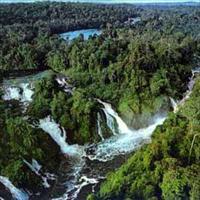Africa announces world’s largest protected freshwater site

The Ngiri-Tumba-Maindombe area in the Democratic Republic of Congo has become the world’s largest Wetland Site of International Importance, officially recognized by the Ramsar Convention. The 6,569,624-hectare site (65,696km²), more than twice the size of Belgium, is situated around the Lake Tumba region in the Central Western Basin of the DRC and contains the largest freshwater body in Africa, the second driest continent. Furthermore its rivers and lakes constitute a major sink for CO2.
Wetlands provide water for drinking and sanitation as well as food, fish, fuel and many raw materials and their total economic value is conservatively estimated to be in excess of $70 billion per year. Support for the DRC government in its effort to win recognition for the Ngiri-Tumba-Maindombe site began in 2004 and was provided jointly by the Central African Regional Program for the Environment (CARPE), a USAID initiative, as well as the Ramsar Convention and WWF, the global conservation organization which was also responsible for the technical aspects of the project.
"WWF is delighted that Ramsar has recognized the importance of this extraordinary wetland and the efforts of the Democratic Republic of Congo to protect it," said James P. Leape, Director General of WWF International. "This is a significant step forward for the welfare of communities who depend on this wetland for their livelihoods and for the wildlife that lives there."
Cassava, sweet potatoes, sugarcane and bananas are all grown in the Ngiri-Tumba-Maindombe site while oil palm plantations, groundnuts and rice are the principal commercial products. Fish from the area also helps to stimulate the economies of big cities such as Kinshasa, Brazzaville and Mbandaka. Vegetation cover at the flood basin acts as a buffer zone against floods for towns all along the Congo River and provides fish with breeding sites, while different forest types help filter water and maintain its quality. It is estimated that, globally, 2.6 billion people lack adequate sanitation services and 1.2 billion people lack access to fresh water.
Until now the world’s largest Ramsar site was Queen Maud Gulf in Canada at 6,278,200 hectares, designated in 1982. The Lake Tumba landscape, encompassing approximately 80,000km2 in total, has one of the highest biodiversity concentrations anywhere in the world. It contains species of conservation concern such as forest elephants, forest buffalo and leopards, there are an estimated 150 species of fish, a wide variety of birds, and three types of crocodile as well as hippopotamus.
Near the centre of the site is Mbandaka, the capital of Equateur province with a population of approximately 750,000, and there are several smaller towns within the site populated by tribes of the Mongo people. Threats to the area’s welfare include illegal logging, fishing and poaching while a decline in water levels in Lake Tumba itself is most probably linked to climate change. Recognition of the site by the Ramsar Convention and the resultant proper management will offer much needed protection from unsustainable activities in future and should ensure the longevity of the water supply.
“The Ngiri-Tumba-Maindombe area contributes to the regulation of flooding and regional climate and ensures that the quality of the water remains good enough for millions of people who depend upon it,” said WWF Project Manager Bila-Isia Inogwabini. “Waters of this zone need to be managed appropriately and the classification of the site will help with a coherent planning process and mobilize all stakeholders to abide by the rules.”
 Back and Next - Back and Next
Back and Next - Back and Next See Also - See Also
See Also - See Also